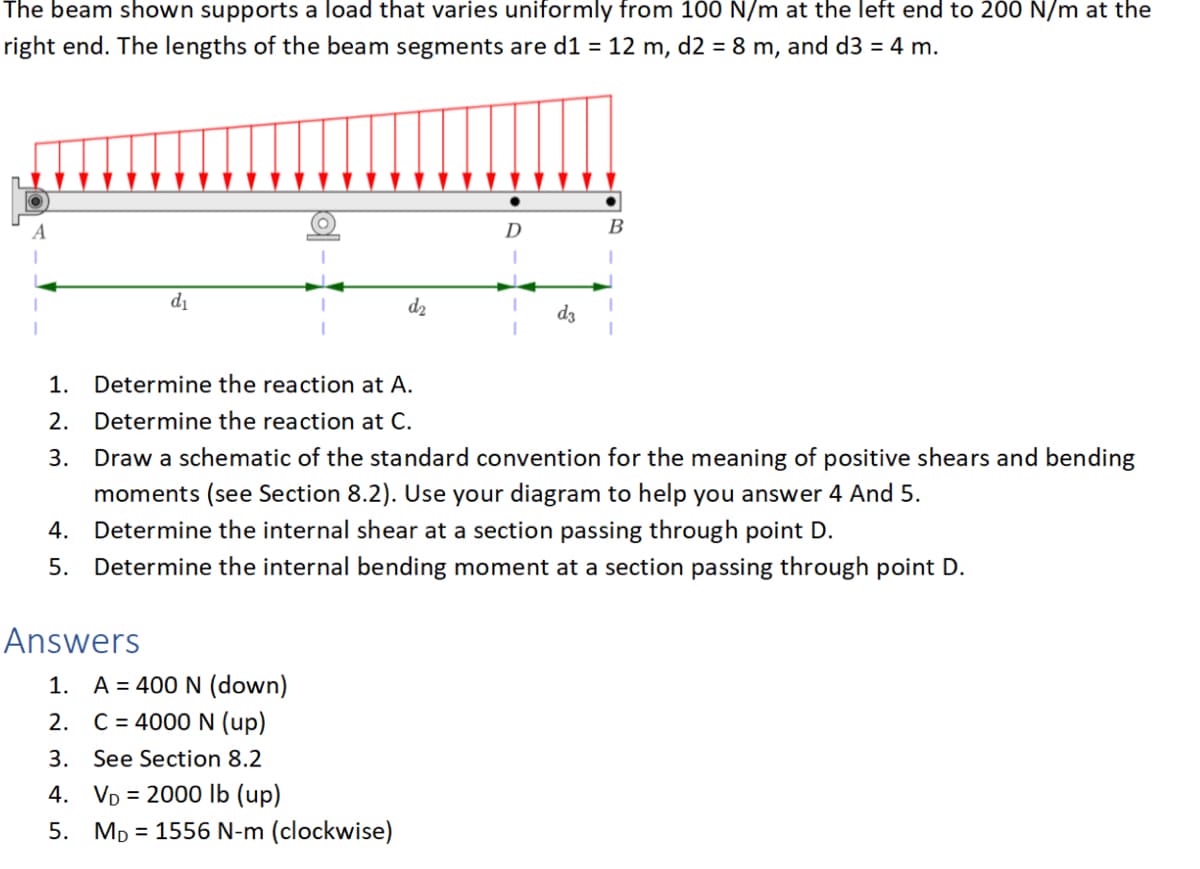The beam shown supports a load that varies uniformly from 100 N/m at the left end to 200 N/m at the right end. The lengths of the beam segments are d1 = 12 m, d2 = 8 m, and d3 = 4 m. d₁ d₂ D d3 1. Determine the reaction at A. 2. Determine the reaction at C. 3. Draw a schematic of the standard convention for the meaning of positive shears and bending moments (see Section 8.2). Use your diagram to help you answer 4 And 5.
The beam shown supports a load that varies uniformly from 100 N/m at the left end to 200 N/m at the right end. The lengths of the beam segments are d1 = 12 m, d2 = 8 m, and d3 = 4 m. d₁ d₂ D d3 1. Determine the reaction at A. 2. Determine the reaction at C. 3. Draw a schematic of the standard convention for the meaning of positive shears and bending moments (see Section 8.2). Use your diagram to help you answer 4 And 5.
Mechanics of Materials (MindTap Course List)
9th Edition
ISBN:9781337093347
Author:Barry J. Goodno, James M. Gere
Publisher:Barry J. Goodno, James M. Gere
Chapter11: Columns
Section: Chapter Questions
Problem 11.5.2P: ‘11.5-2 A steel bar having a square cross section (50 mm × 50 mm)and length L = 2.0 in is compressed...
Related questions
Question
Pls all of them

Transcribed Image Text:The beam shown supports a load that varies uniformly from 100 N/m at the left end to 200 N/m at the
right end. The lengths of the beam segments are d1 = 12 m, d2 = 8 m, and d3 = 4 m.
d₁
d₂
Answers
1.
A = 400 N (down)
2.
C = 4000 N (up)
3. See Section 8.2
4. VD = 2000 lb (up)
5. MD = 1556 N-m (clockwise)
D
d3
B
1. Determine the reaction at A.
2. Determine the reaction at C.
3. Draw a schematic of the standard convention for the meaning of positive shears and bending
moments (see Section 8.2). Use your diagram to help you answer 4 And 5.
Determine the internal shear at a section passing through point D.
4.
5. Determine the internal bending moment at a section passing through point D.
Expert Solution
This question has been solved!
Explore an expertly crafted, step-by-step solution for a thorough understanding of key concepts.
Step by step
Solved in 4 steps with 4 images

Knowledge Booster
Learn more about
Need a deep-dive on the concept behind this application? Look no further. Learn more about this topic, mechanical-engineering and related others by exploring similar questions and additional content below.Recommended textbooks for you

Mechanics of Materials (MindTap Course List)
Mechanical Engineering
ISBN:
9781337093347
Author:
Barry J. Goodno, James M. Gere
Publisher:
Cengage Learning

Mechanics of Materials (MindTap Course List)
Mechanical Engineering
ISBN:
9781337093347
Author:
Barry J. Goodno, James M. Gere
Publisher:
Cengage Learning